Day 2 of a three day Autumn Tour today, and we headed over to the Wash for the Wader Spectacular this morning. It was a cloudy start but brightened up late morning and we even had some sunny intervals in the afternoon.
It was an early start this morning, in order to get over to Snettisham ahead of the rising tide. As we got out onto the seawall, a Turtle Dove flew up round across the track ahead of us. We watched it fly down over the pit and land on a bush the other side, where we could get it in the scopes. A nice bonus to start.
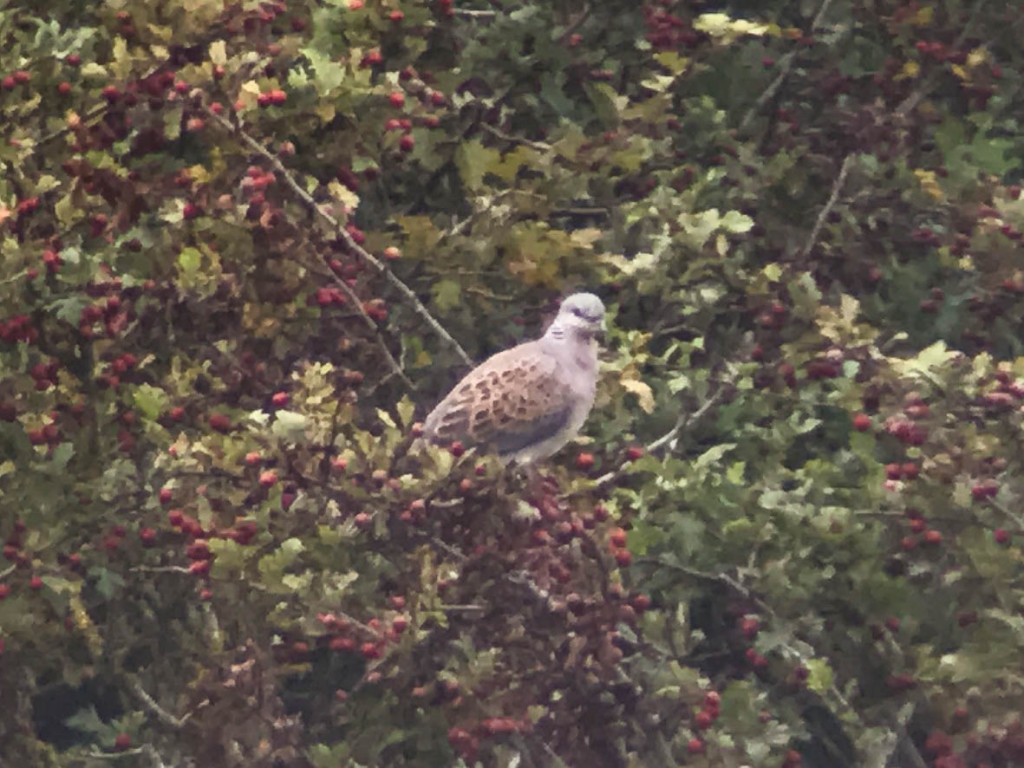
Their was still lots of exposed mud from here, but the water was coming in fast. We could see a large dark slick on the mud away to the north, a large flock of several thousand Oystercatchers gathered up towards the sailing club. Nearby was a huge flock of mainly Bar-tailed Godwits – through the scopes we could see a few still sporting the remnants of their rusty breeding plumage. There was a gathering of gulls on the mud too, including several Mediterranean Gulls, plus a number of both Sandwich and Common Terns.
There were more waders on the mud closer to us. Lots of Ringed Plovers, a few Dunlin, Turnstone and Knot, plus Curlews and Redshanks. Two Sanderling dropped in right down below us briefly. Looking out across the Wash, we could see thousands of Knot now, whirling round in the sky, making lots of different shapes. Something was obviously stirring them up out there this morning.
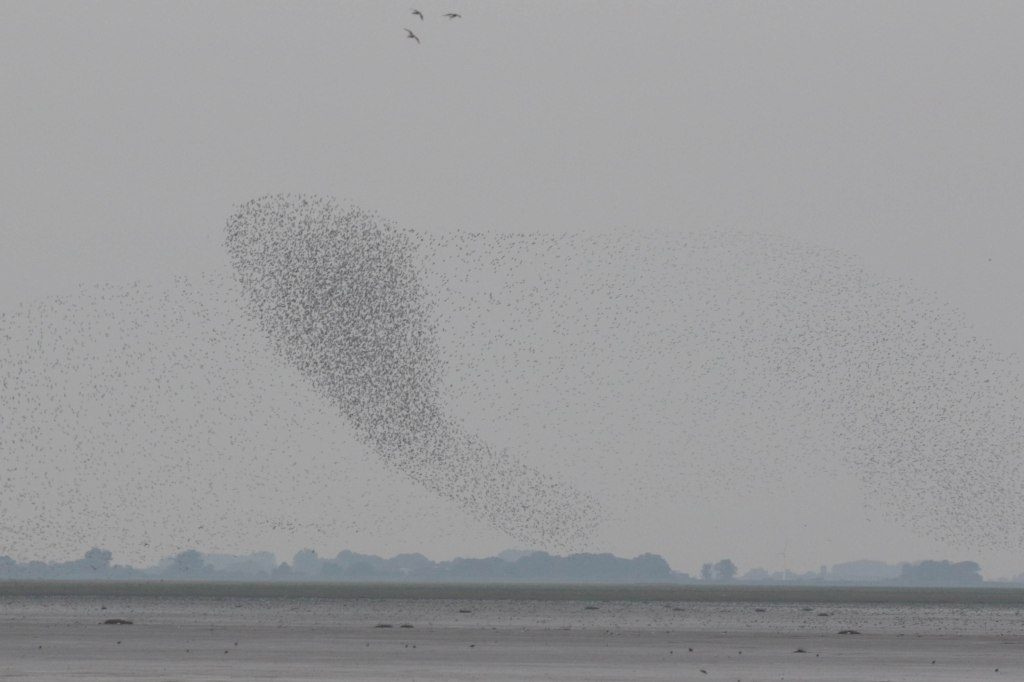
The tide was coming in quickly, and after a while all the Bar-tailed Godwits started to lift off in large groups, flying past us and landing out on the drier mud to the south. Then the Oystercatchers followed and soon, there were no waders left on the mud in front of us. We moved on down to Rotary Hide.
We stopped and watched the flocks again from here. The Oystercatchers were gathered out in the middle, and as the rising waters eventually caught up with them again, we watched as they started to walk away from tide, the whole black slick looking like it was flowing across the mud. The March of the Oystercatchers – great to watch! Some of the godwits and Knot were walking away from the tide too today, following the Oystercatchers. Others flew up from the edge of the water and landed higher up.
We carried on down to the end and got ourselves into position. As the water continued to come in apace, the waders were increasingly tightly concentrated in the last corner. Many of the Knot had gathered further out around the Wash today and as they were forced up by the rising tide, huge flocks each several thousands strong flew in from the distance beyond. There didn’t look to be any room for them, but they all dropped down to join the already packed throngs on the mud in the corner.
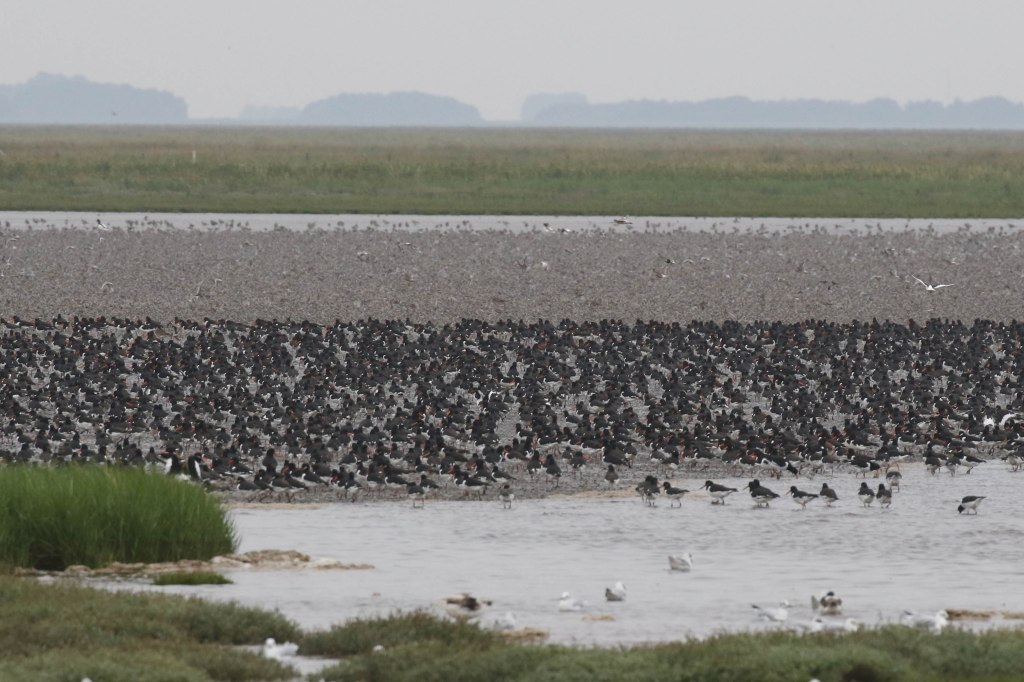
The Oystercatchers saw the writing on the wall first, and started to peel off in lines, flying in past us piping noisily. Eventually the first wave of Knot erupted, a thick cloud like smoke, tens of thousands of birds. Some came straight in over our heads, so we could hear the beating of hundreds of pairs of wings. Others towered up over the Wash and came in much higher, in over the pit behind us.
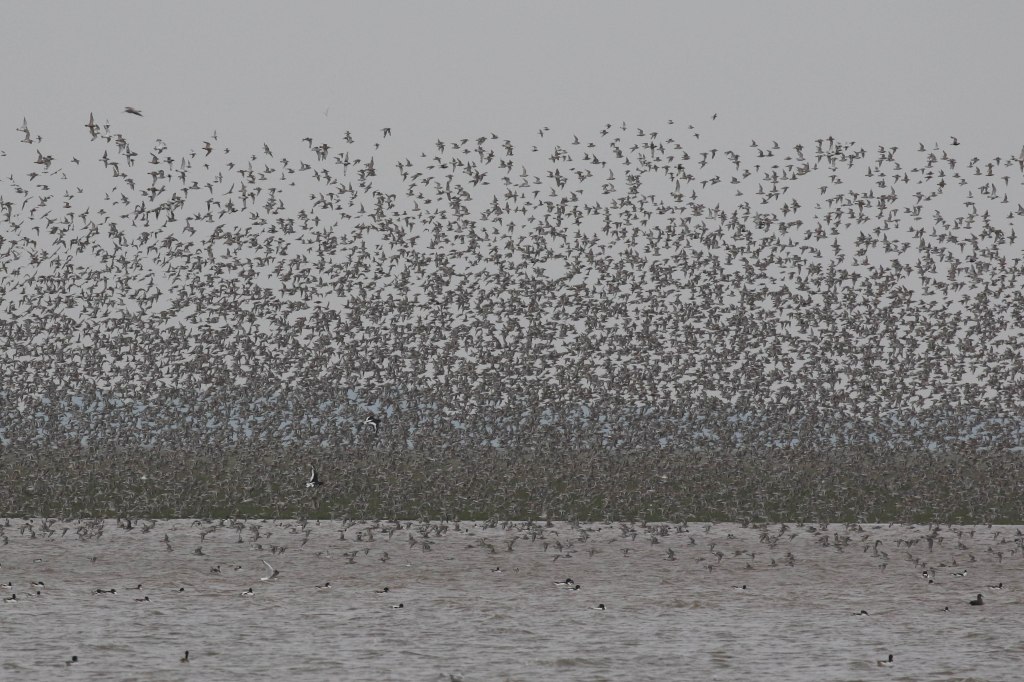
We watched the huge flocks of Knot circling behind us, and swirls of birds broke off from the bottom of the flock and spiralled down towards the islands on the Pit, almost as if a giant vacuum cleaner hidden below was sucking them out of the sky. The airspace over the Pit was getting congested now, and as more waves of Knot came up from the Wash, other groups circled back out over the Wash.
The islands were obviously filling up fast, again the birds seemed to be shunning the islands to the south of the Pit. More and more birds turned back out over the Wash and we watched the huge flocks of Knot climbing higher & higher, back and forth, towering up. We watched in awe from below.
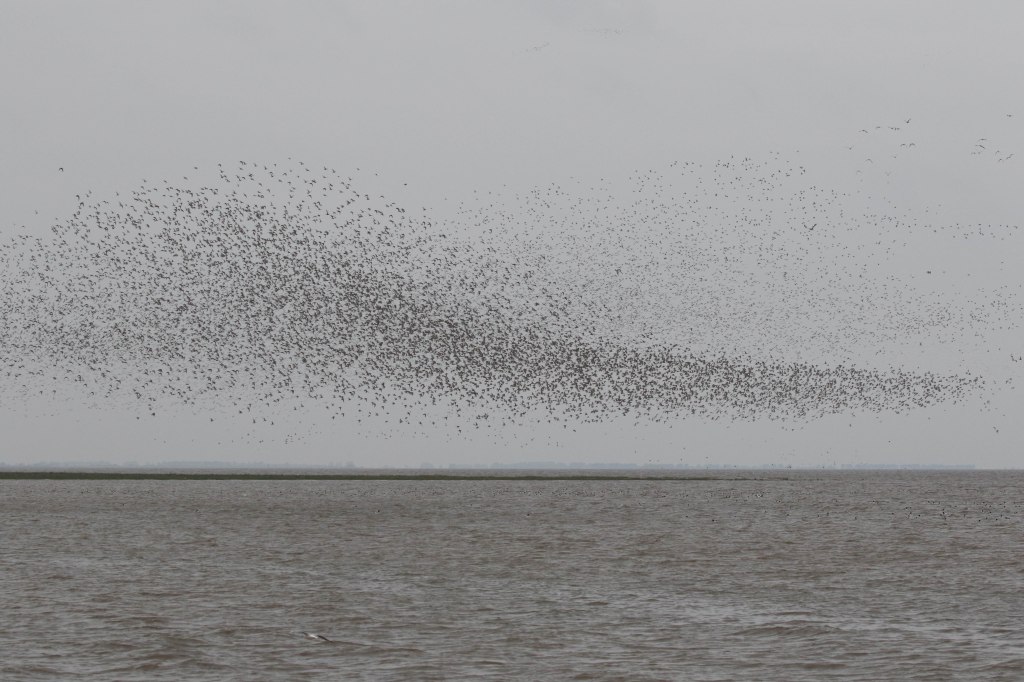
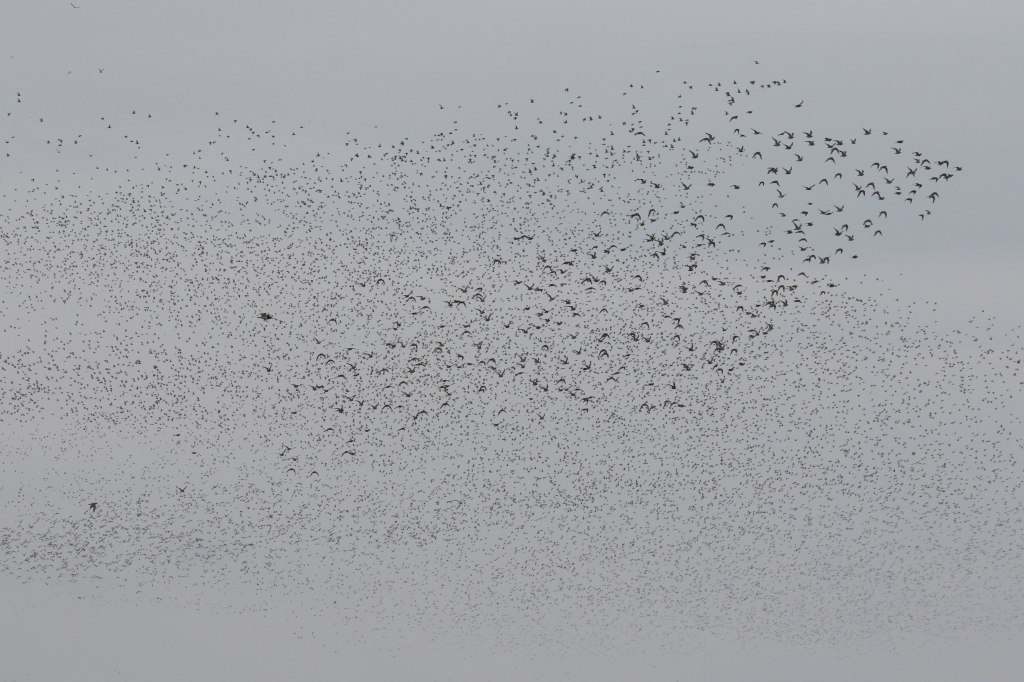
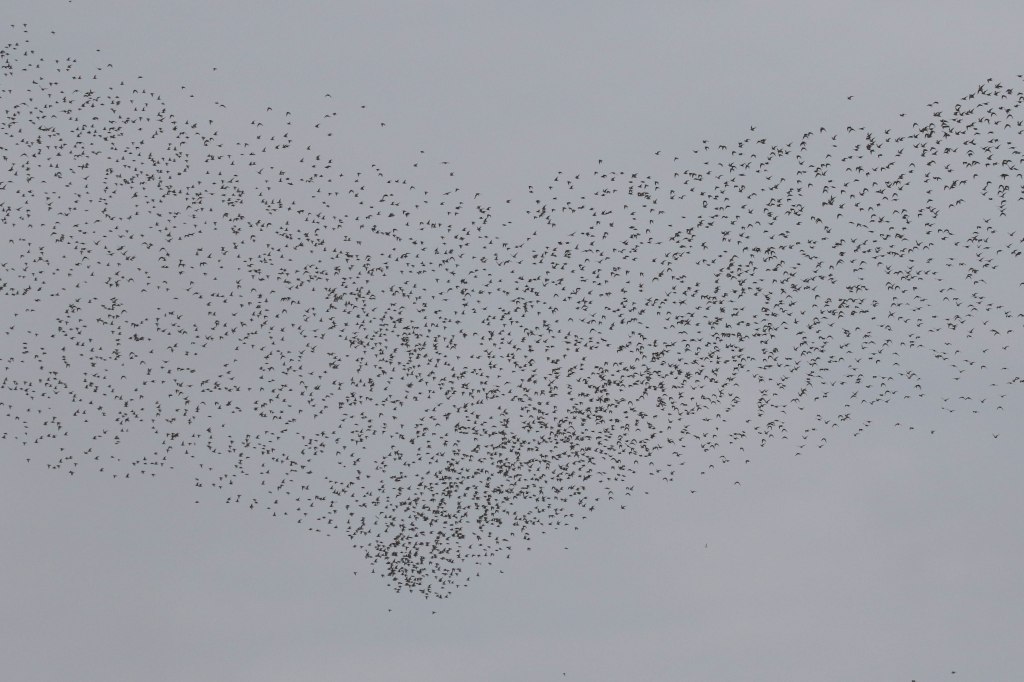
A lot of birds had already disappeared down onto the Pit behind us when suddenly they erupted in panic. We heard a huge whoosh as they all took to the air and turned to see a thick mass of birds twisting and turning above the water. A young Peregrine appeared from the middle of them. It seemed to have missed its chance, lost the element of surprise, but as it flew back away from the Pit it managed to catch something small, presumably a Knot. We watched it disappearing off inland, trying to dispatch its struggling prey on the wing.
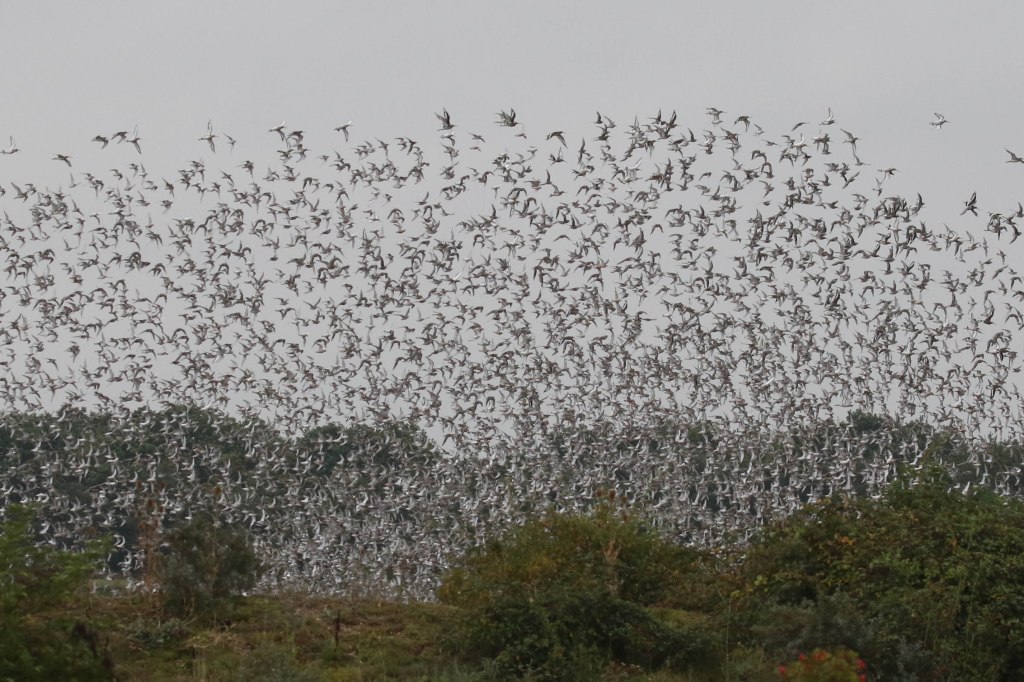
As the huge flocks continued to fly round overhead, backwards and forwards, we spotted three Spoonbills with them. We didn’t see where they came from, perhaps up from the Pit when the Peregrine attacked or from out on the Wash. They circled briefly, then drifted off north.
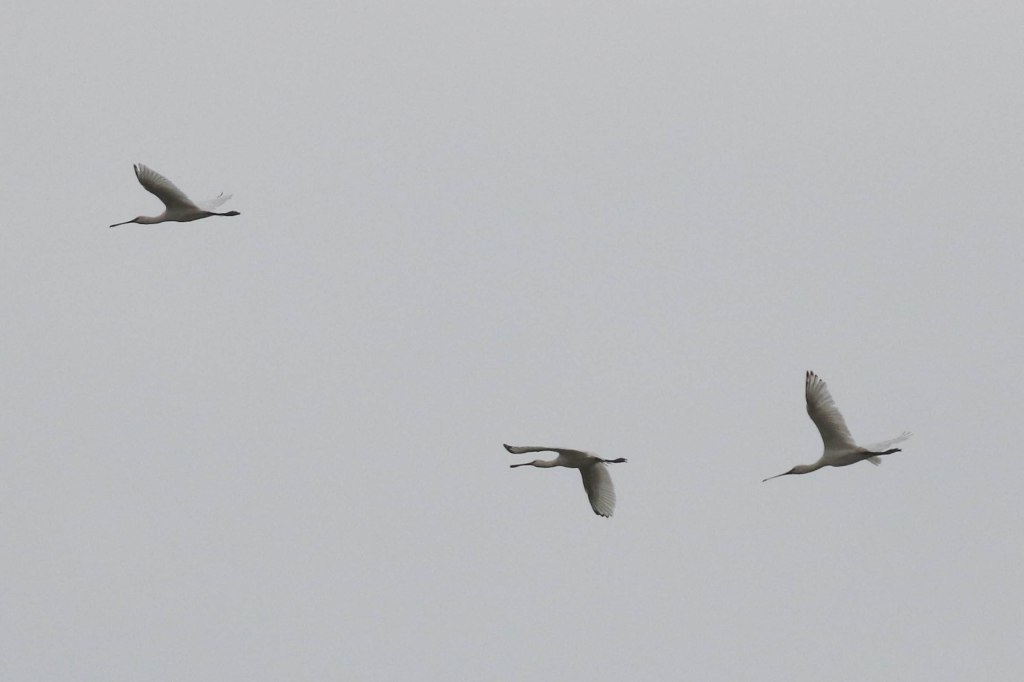
Yet another vast flock of Knot came up from the Wash and in over the Pit. Some managed to land, others headed back out again. We could still see thousands of birds towering high into the sky, others managed to land tight in the corner of the Wash in the shallow water. It was slack tide now, and gradually the excitement died down a little. There were still quite a lot of Knot out on the Wash today, packed in with all the larger waders like Curlew and Bar-tailed Godwits which always stay out.
We could see the hides were busy – lots of people had run off to get their seats even before the action had finished – so we chatted a while to let the initial rush subside. The Knot that had come in were all packed onto the islands north of Shore Hide again, and the hide was still full when we walked over. We waited outside for a bit and eventually got in, only to find that a rank of photographers had taken up occupation of all windows overlooking the islands again.
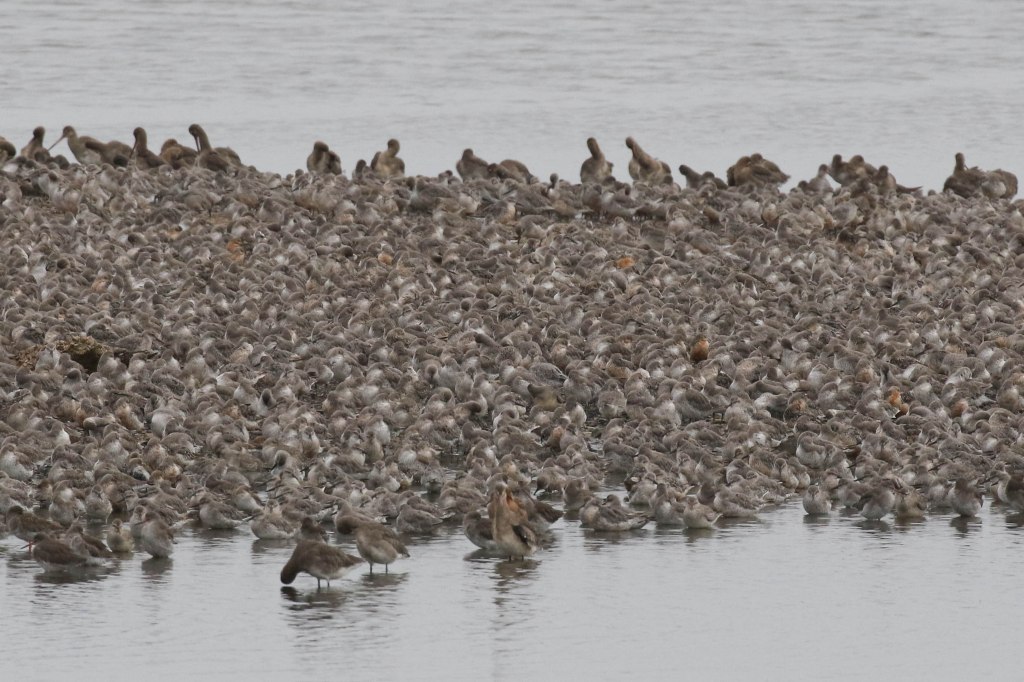
Five Spotted Redshanks were roosting in their usual spot, out in the middle with the Cormorants, but were mostly asleep now. We eventually found an angle where we could set up the scope and see through between people to the nearest of the Knot flocks. The first birds we saw were three Little Stints with the Dunlin on the edge of the throng.
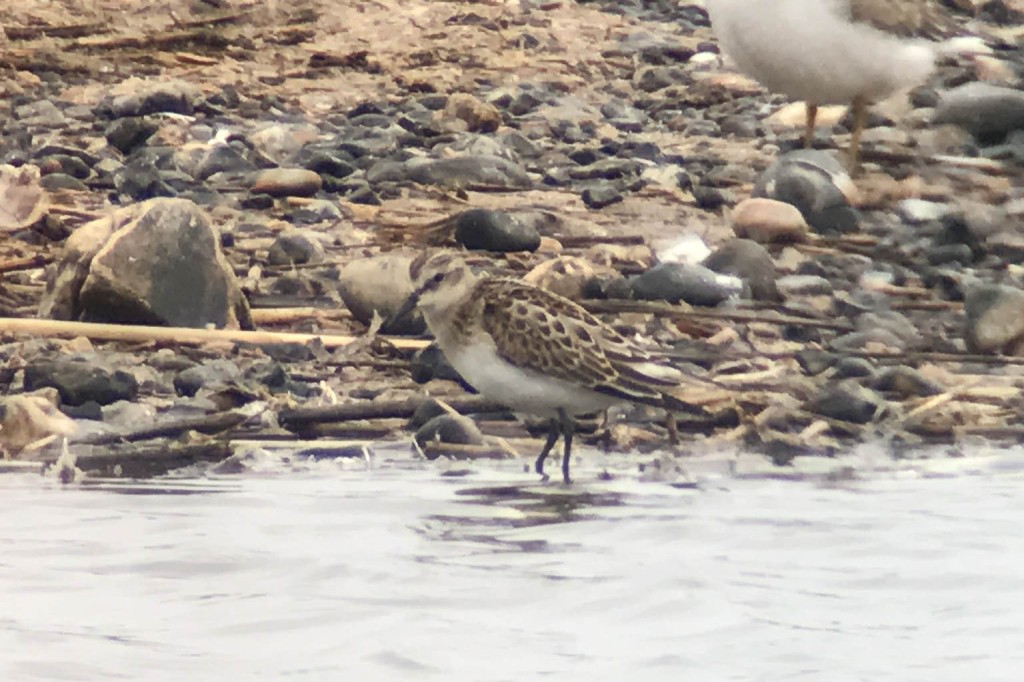
The banks either side and islands at the south end of the Pit were covered in Oystercatchers. We had a careful scan round the edge and found a single Common Sandpiper on the shingle in front of South Hide. Then we headed back out to let someone else have a turn in the hide.
There were loads of Shelducks bobbing out on the water over high tide. We later discovered it was WeBS count day, and RSPB staff had counted 1,560 Shelduck here today (along with 56,000 Knot!). Two Little Stints flew round over the water, but it was hard to tell if they were birds which had been on the island earlier or different. We had seen one or two Swallows heading south earlier, and a big flock of Swallows and House Martins drifted back overhead now.
The tide was starting to go out, and the birds started shifting a bit. As the flocks in the corner started to space our, we could see lots of Grey Plover now, some still sporting their summer black faces and bellies, but most at least looking more patchy now. Scanning through the lines of terns out on the mud, we found quite a few Little Terns now, in amongst lots of Common Terns and quite a few Sandwich Terns.
Lines of Knot started coming up over the bank from the Pit and heading out low over the water towards the corner. Lines of Oystercatchers came out too. Several quite large groups flew out, as well as some dribs and drabs, and then it went quiet. We walked over and looked over the bank and could still see lots of birds on the islands on the Pit, but they were showing no sign of moving, despite it being about an hour and a half after high tide now.
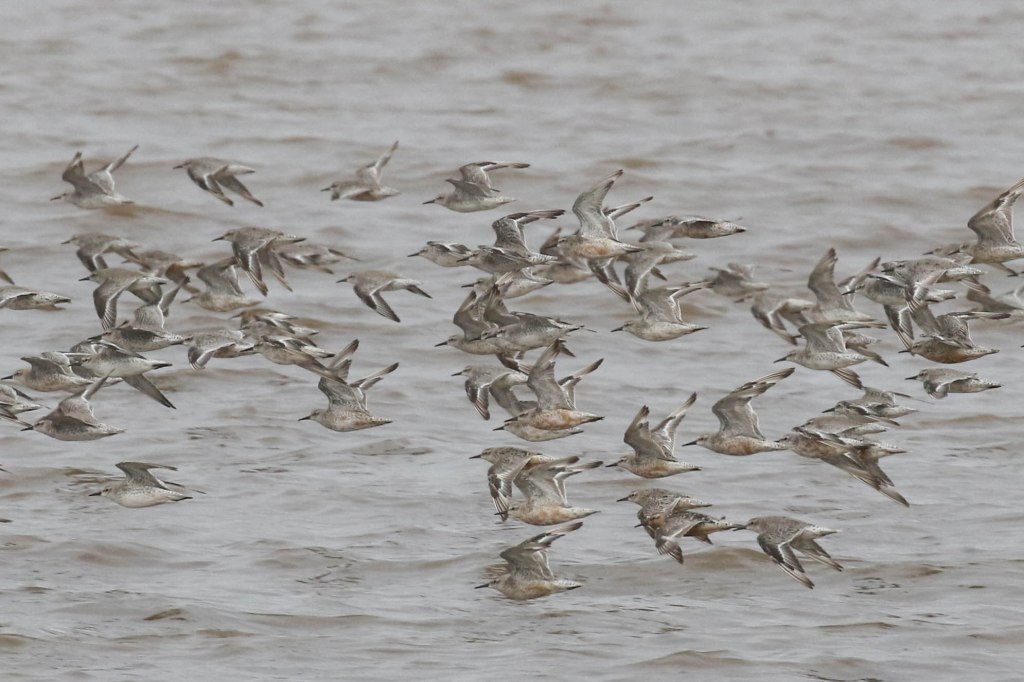
We decided to head back. We called in briefly at Rotary Hide on our way past, where lots of Turnstones were roosting on the nearest island, another Common Sandpiper with them. On our way back along the seawall, we stopped to admire a large roosting flock of several hundred Sanderlings on the beach.
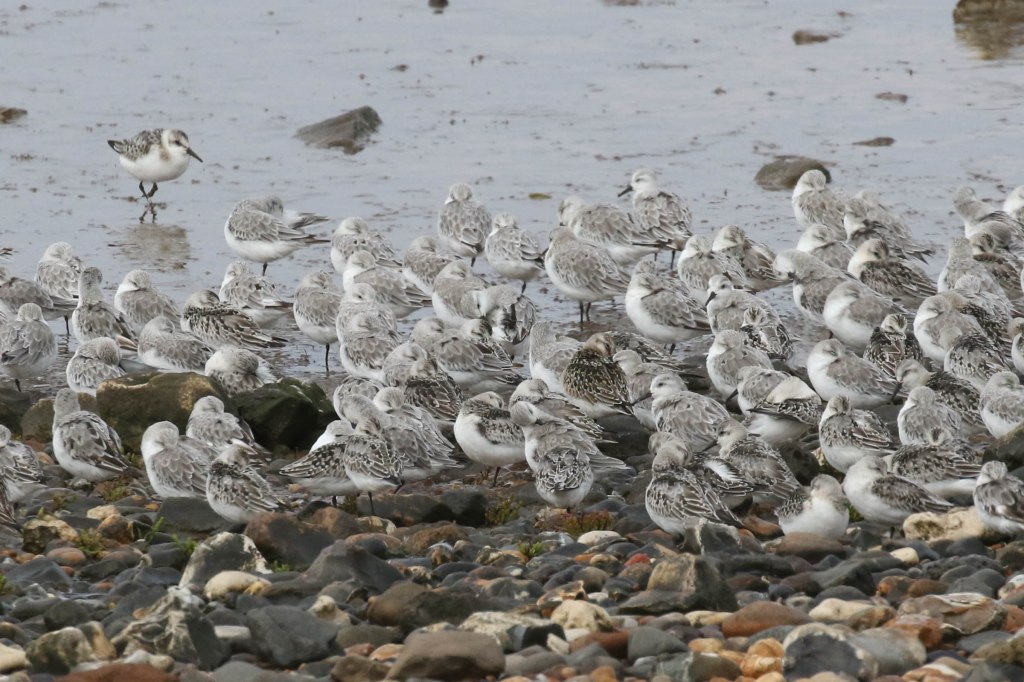
We headed over to Titchwell for the afternoon, cutting across inland to avoid the traffic. A Red Kite was hanging in the air over the fields on the way. We stopped for lunch in the picnic area first – several Speckled Woods and a single very smart fresh Comma, as well as Common Darter dragonflies were fluttering around the vegetation and basking in the sunshine. A Bank Vole worked its way round through the undergrowth.
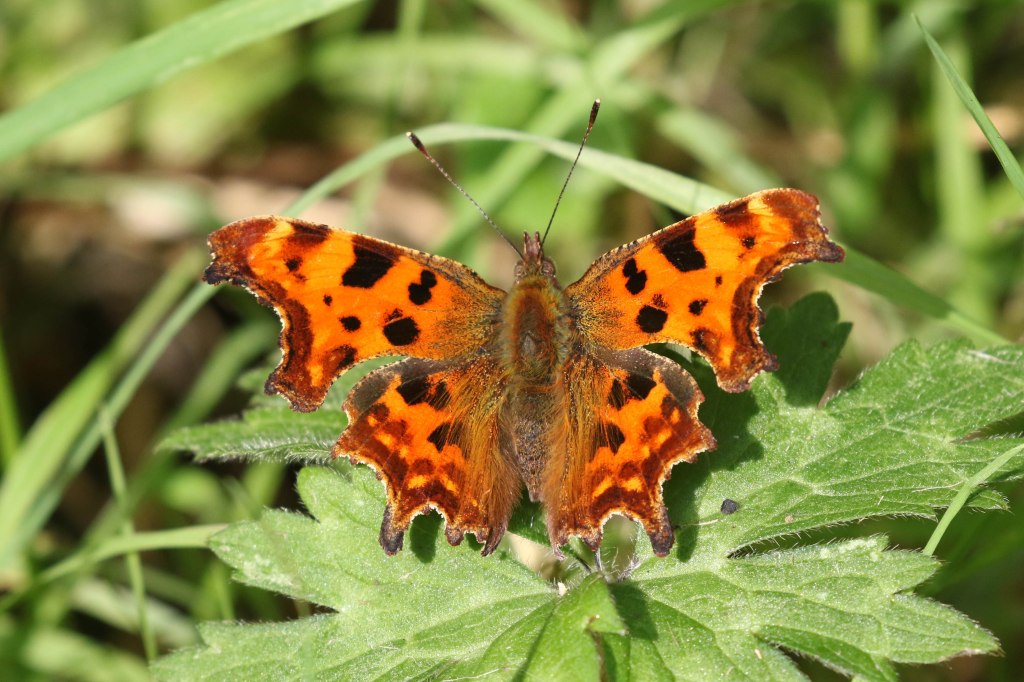
After lunch, we headed out onto the reserve. As we walked down along Fen Trail, we could hear several Chiffchaffs calling in the trees. Out onto the Tank Road, we arrived just as a flock of birds passed through. We managed to see a couple Blackcaps eating berries in the elders, and found a Garden Warbler with them briefly, before they flew deeper in. A Chiffchaff remained preening in the bushes on the edge.
We went straight round to the end of Autumn Trail first. When we got there we found a few people looking but they had seen no sign of the Pectoral Sandpiper which is still lingering here. There were four close juvenile Little Stints which were nice to watch, along with a few Dunlin, Ringed Plovers and several Ruff too enjoying the mud which had been churned up by the diggers. Another Bank Vole was chewing on a blade of grass on the edge of the path, seemingly unconcerned by all the people standing there.
We kept scanning along the edge of the fenced-off island at the back, which is the area the Pectoral Sandpiper has been favouring. There were several more Ruff over the back and we did see a single Spotted Redshank asleep in front, but presumably our target was hidden in the flooded vegetation behind the fence.
Suddenly something spooked everything, and all the birds flew out of the fence – lots of Teal and Ruff. A careful scan and we found the Pectoral Sandpiper too. A very smart, clean, juvenile, it kept getting hidden by the Herring Gulls loafing on the island in front, but eventually we all had good views through the scope out in the open.
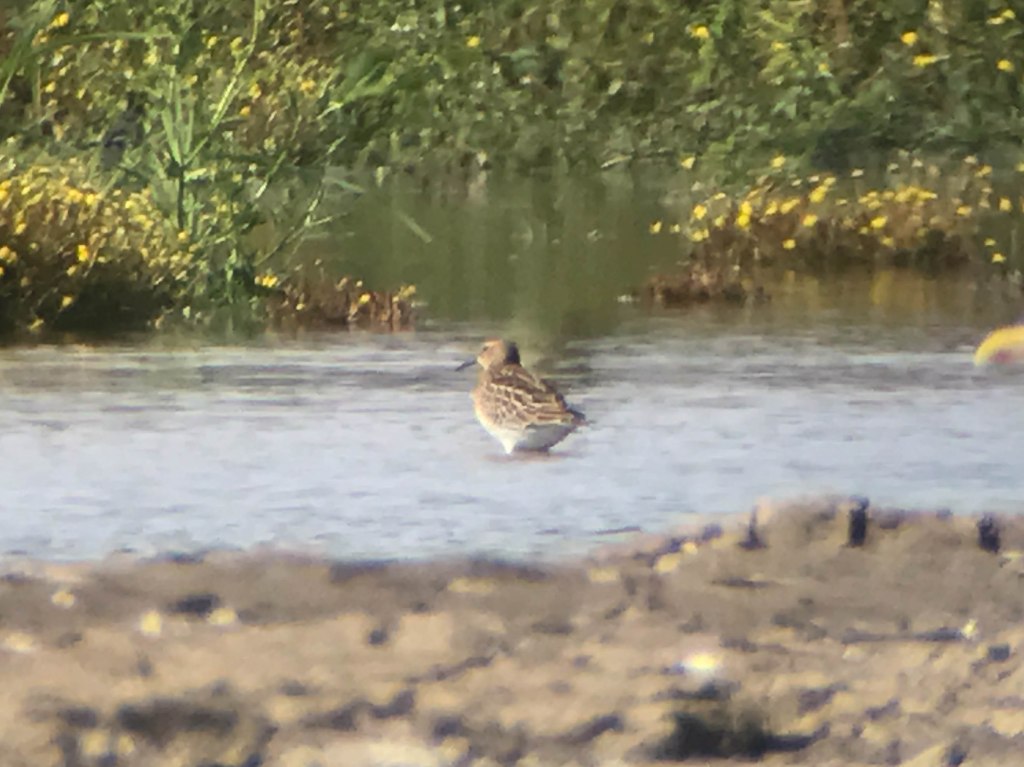
The Pectoral Sandpiper stayed out in the water for several minutes, looking round at first, then stopping to preen, before it walked back to the edge of the vegetation. We had a good view as it started to feed of the distinctive pectoral band formed by the bottom of the streaks on its breast. Then it was chased by one of the Ruff, and disappeared back further in. Amazing to think that it has travelled all the way from North America or perhaps more likely the far north-east of Siberia!
We walked back to Patsy’s and stopped on the benches for a scan of the pool. There were lots of Coot and Gadwall, including some very smart drakes. Two eclipse drake Pintail were upending right at the back, in front of the reeds. There were a few Common Pochard too and several Little Grebes.
As we made our way back through the trees along Fen Trail, we saw at least three Willow Emerald damselflies perched on branches by the path. A fairly recent colonist, it is very well established here now. A Common Toad was sitting in the middle of the boardwalk.
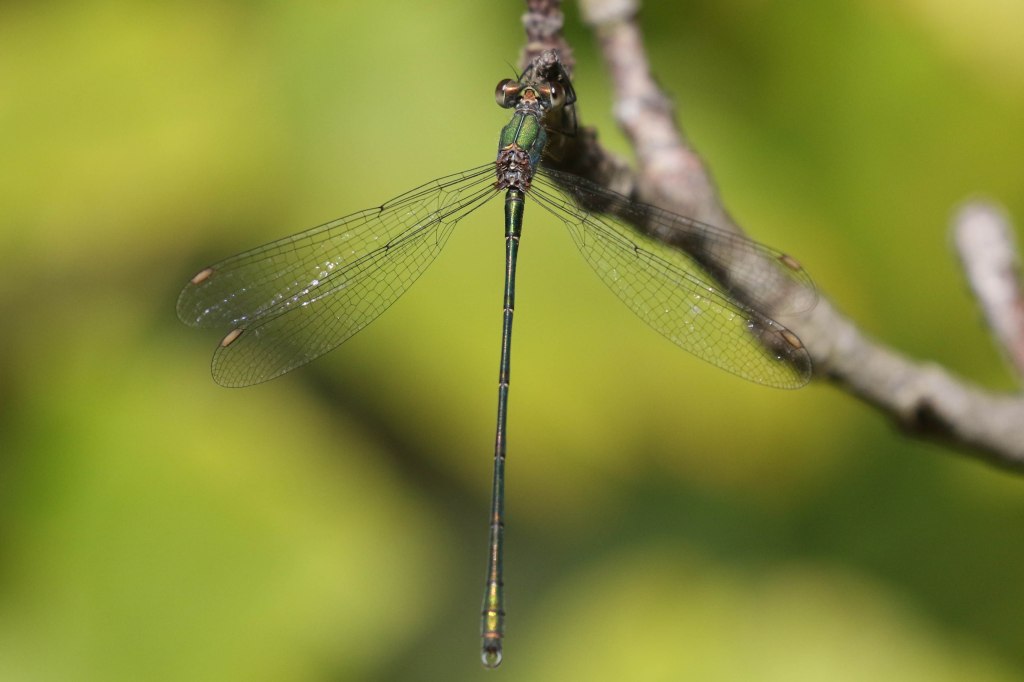
We cut across on Meadow Trail to the main path and walked up towards the Freshmarsh. The reeds were fairly quiet today, not helped by a freshening breeze. A Grey Heron was lurking on the edge of one of the tracks made by the digger through the reeds. Two more Common Pochard and two Little Grebes were on the reedbed pool, and another couple of Little Grebes on the channel beyond. A Cetti’s Warbler was singing, typically well in the bushes.
We went down into Island Hide and were pointed by one of the volunteers to a Wood Sandpiper feeding on the mud in front of the reeds. A single Common Snipe appeared nearby. There was a nice close Ruff, its loose back feathers typically billowing up in the breeze, and an irridescent green Lapwing on the mud right in front of the hide. Avocet numbers have declined significantly, but there were still around a dozen on the Freshmarsh this afternoon, including a close juvenile feeding in front of the hide. Several Golden Plover were over towards the new bund and a few Black-tailed Godwit were asleep on one of the new islands.
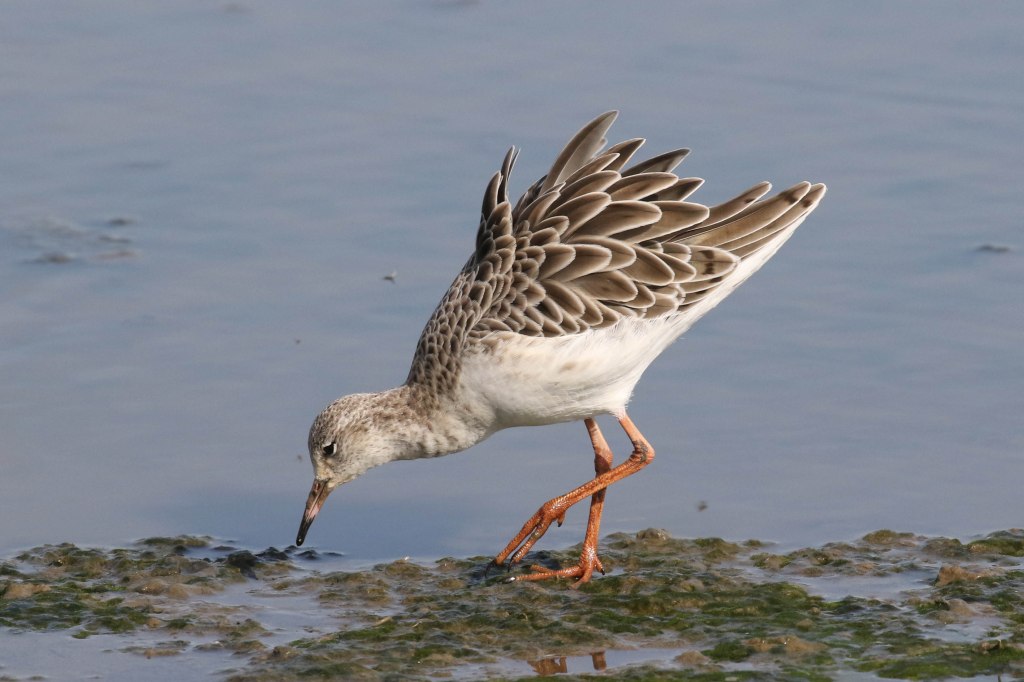
There were more Gadwall on here, including another smart drake, and several Shoveler, the males all still in drab eclipse plumage. One of the drake Teal was just starting to get some head colour again.
A Water Rail appeared, working its way along the edge of the reeds out to the right of the hide. Then another came out into the open on the mud a little further back. As if not to be outdone, the first Water Rail then reappeared and also came right out onto open mud where we got a great look at it.
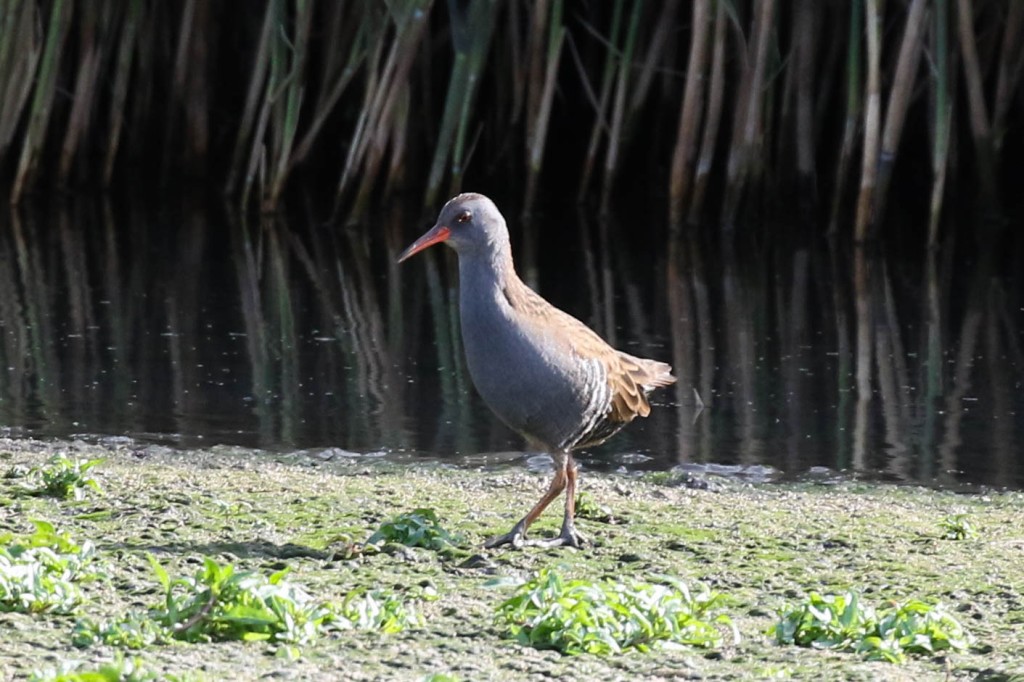
One of the group saw a small bird flick into the dead reeds on the edge where the diggers had cleared and after a minute or so a Reed Warbler emerged. A few minutes later, a male Bearded Tit appeared in exactly the same place, although it only stayed out briefly before dropping back in. A Great White Egret came up from the near edge of the reedbed and flew off back in the direction of Patsy’s.
There was a shout of ‘Hobby‘ from the volunteer we had spoken to earlier but it dropped down out of sight before he could get us onto it. It had been a long day, so we decided to head back now. On our way back to the visitor centre, we were just in time to see the Hobby heading out across Thornham grazing marsh. Then it was time to head for home – more tomorrow.
















